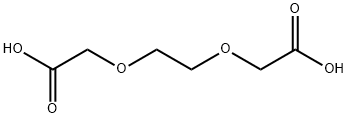3,6-DIOXAOCTANEDIOIC ACID

|
- ₹0
- Product name: 3,6-DIOXAOCTANEDIOIC ACID
- CAS: 23243-68-7
- MF: C6H10O6
- MW: 178.14
- EINECS:245-516-9
- MDL Number:MFCD00054502
- Synonyms:3,6-Dioxasuberic acid;Acetic acid, 2,2'-[1,2-ethanediylbis(oxy)]bis- (Triglycolic acid);Acetic acid, 2,2‘-[1,2-ethanediylbis(oxy)]bis-;(2-CARBOXYMETHOXYETHOXY)ACETIC ACID;2,2'-(Ethane-1,2-diylbis(oxy))diacetic acid;3,6-dioxoctanedioic acid;PEG2-(CH2CO2H)2;2-[2-(Carboxymethyloxy)ethoxy]acetic acid
| Manufacturer | Product number | Product description | Packaging | Price | Updated | Buy |
|---|
Properties
Melting point :68-71℃
Boiling point :429.2±25.0 °C(Predicted)
Density :1.375
vapor pressure :0Pa at 20℃
storage temp. :Keep in dark place,Sealed in dry,Room Temperature
pka :3.09±0.10(Predicted)
form :solid
color :White to off-white
LogP :-2.29 at 25℃
Boiling point :429.2±25.0 °C(Predicted)
Density :1.375
vapor pressure :0Pa at 20℃
storage temp. :Keep in dark place,Sealed in dry,Room Temperature
pka :3.09±0.10(Predicted)
form :solid
color :White to off-white
LogP :-2.29 at 25℃
Safety Information
| Symbol(GHS): |

|
||||||||||||||||||||||||||||
|---|---|---|---|---|---|---|---|---|---|---|---|---|---|---|---|---|---|---|---|---|---|---|---|---|---|---|---|---|---|
| Signal word: | Warning | ||||||||||||||||||||||||||||
| Hazard statements: |
|
||||||||||||||||||||||||||||
| Precautionary statements: |
|
Description
PEG2-(CH2CO2H)2 is a PEG linker containing two terminal carboxylic acid groups. The hydrophilic PEG spacer increases solubility in aqueous media. The terminal carboxylic acids can react with primary amine groups in the presence of activators (e.g. EDC, or HATU) to form a stable amide bond.More related product prices
PEG5-(CH2CO2H)2 13887-98-4 Diglycolic acid HOOCCH2O-PEG6-CH2COOH DIMETHYL PERFLUORO-3,6-DIOXAOCTANE-1,8-DIOATERelated product price
- 13887-98-4
₹4947.03-27993.45 - Diglycolic acid
₹1796.95-27246.53






